28 October, 2023
by Catherine Lim
It was the April-Jun 2012 edition of Nature Watch, the Nature Society of Singapore (NSS) bi- monthly magazine of hot topics. This one featured the position paper and recommendations for Bukit Brown Cemetery together with a ed-op piece and photo feature titled “Spirit of Bukit Brown” The latter by Ilsa Sharpe, who was on a visit from Perth, which was now home. A revisit was undertaken in the light of news following the announcement of an eight-lane highway that would bifurcate the cemetery.
First Dr. Ho Hua Chew presented some of the reasons for preservation:
ECOSYETEM SERVICES
1) Carbon Sequestration
While our eco footprint is on par with that of first world nations then, “Singapore should take up the challenge of becoming not just a red dot to the world, given that the crisis of global warming has intensified to an alarming degree.”
12 years later climate change is an existentialist crisis. Globally, governments have had to face extreme weather devastation from blistering heat to numb blinding cold. Mitigating climate change requires new sustainable and equitable goals. There is a place for Bukit Brown in this.
2) Natural air-conditioning. If you have ever been to Bukit Brown, then you will have felt what I mean. Nothing more to say.
3) Rainfall sponge. It rains often in Singapore, but it also evaporates fast in our concrete jungle, the wooded areas of Bukit Brown, retains water, and “allow a slower percolation of water into the ground.” This helps prevent or reduce floods.”
Biodiversity
With the formulation of the Master Plan for the Conservation of Nature which was published, NSS had been monitoring the bird life in Bukit Brown.
Their highlights:
94 resident and migrant bird species have been recorded. That’s 26% of 364 bird species recorded under the NSS checklist in 2007. “Impressive” is how Ho describes this figure, given the landscape is mainly woodland.
Nationally threatened birds include the White-bellied Woodpecker (critically endangered and rare). The Spotted Wood Owl and Grey-headed Fish Eagle all in the same category of rare, and critically endangered; 56 species listed in the Red Data Book is 27%, making the cemetery an important site for biodiversity conservation.
Forest Birds – Extended Habitat
Bukit Brown serves as an important habitat and foraging ground for many forest species. Their presence which includes the Malkoha, Asian Fairy Bluebird and Black-headed Bulbul is probably due to over-crowding, especially at the Macritchie Forest part of the Central Catchment Nature Reserve (CCNR)., opposite Lornie Road where Bukit Brown is located. There is also a disconnect with the reservoir and the golf course at Sime Road to the west, and the dam and open ground to the east.
From Bukit Brown it is “a skip and a hop” to the Southern Parks and Ridges. With the cemetery situated south of CCNR, it acts “as a bridge” to include Botanic Gardens to the Istana and Fort Canning. Bukit Brown facilitates as close to a contiguous route for forest birds to the South.
An interesting record of a Large Flying Fox was sighted close to the expressway transect area. A common sight in the past, it is now nationally extinct. It was probably a visitor from Johor or Indonesia. It is a rare sighting which indicates Bukit Brown holds promise for other wildlife apart from the birds.
Since this article was written, there have been sightings by the tomb keepers of the rare Sunda Pangolins as reported by all things Bukit Brown.
To summarise the impact of an eight- lane highway:
The expressway approximately 2 km in length cuts through the area close to MacRitchie Forest, going diagonally across the only big valley with a flowing river, and I would add the most beautiful part of Bukit Brown, with thick woodlands along the shoulders and surround areas on both sides of the valley.
Most of these will probably be wiped out by the construction of the highway. Most of the forest species which used Bukit Brown as a launching pad for foraging will lose their habitat because of the damage and destruction, wreaked. Forest birds are not long-distance flyers. The proposal for the 600 meter “vehicular bridge” although allowing for the river to continue flowing, will with its massive width cast a huge shadow underneath. Deprived of sunlight, the plants will wither and die.
In, 2012:
The Nature Society of Singapore recommends and advocates:
The whole of area of Bukit Brown be designated as a heritage park, with cultural and nature/ecological components integrated into one entity. This also allows for other recreational facilities and activities that are in harmony with the dual-heritage dimension of the park. Such activities include horse riding strolling, hiking, cycling and more. The heritage park should be proposed to the UN as an UNESCO World Heritage Park to draw the tourists – if Singapore ratifies the UNESCO World Heritage Convention. “
On May 15. 2014, having ratified the convention, the Botanic Gardens was inscribed as our first UNESCO Heritage Site.
In 2023, all things Bukit Brown, advocates and recommends that Bukit Brown Cemetery be considered for inscription as the twin to Botanic Gardens, following its success. Also, a cultural site, it tells the story of our migrant nation, embedded with exquisite and simple stonework, with inscriptions that speak of revolution and peace, and represents tangible records of ordinary times of ordinary lives from Coolies to Capitan Cinas, in colonial times.
One of the rare battlegrounds from WWII which are still intact in parts, despite the highway which cut through the last known locations where soldiers were recorded to have fell. There are mass graves from WWII still not uncovered.
Lest we forget.
This will be a fitting remembrance of our war dead, a memorial and a national heritage park.
Remember Where We Came From
“We are Singaporeans together on a small island. We are anchored by our emotional links with family and friends and by our shared sense of our history, and our common destiny. We are not just here, materialised from nowhere, appeared out of a Transformers movie, maybe, we came here somewhere, sometime there was a history to it and it is crucial to remember where we came from, how we got here”
PM Lee Hsien Loong, National Day Rally speech, 2011
~~~~~~~~~~~~~~~~~~~~~~~~~~~~~~~~~~~~~~~~~~~~~~~~~~~~~~~~~~~~~~~~~~~~~~~~~~~~~~~~~~
There is a Chinese saying, ” 飲水思源” translated, “remember the source of the water.”
Horse-riding and strolling, extracted from Nature Watch 2012
Intertwining Guided Walks of History, Habitat and Heritage
It’s like a three- in-one and atBB has recorded over 20,000 participants to such walks.
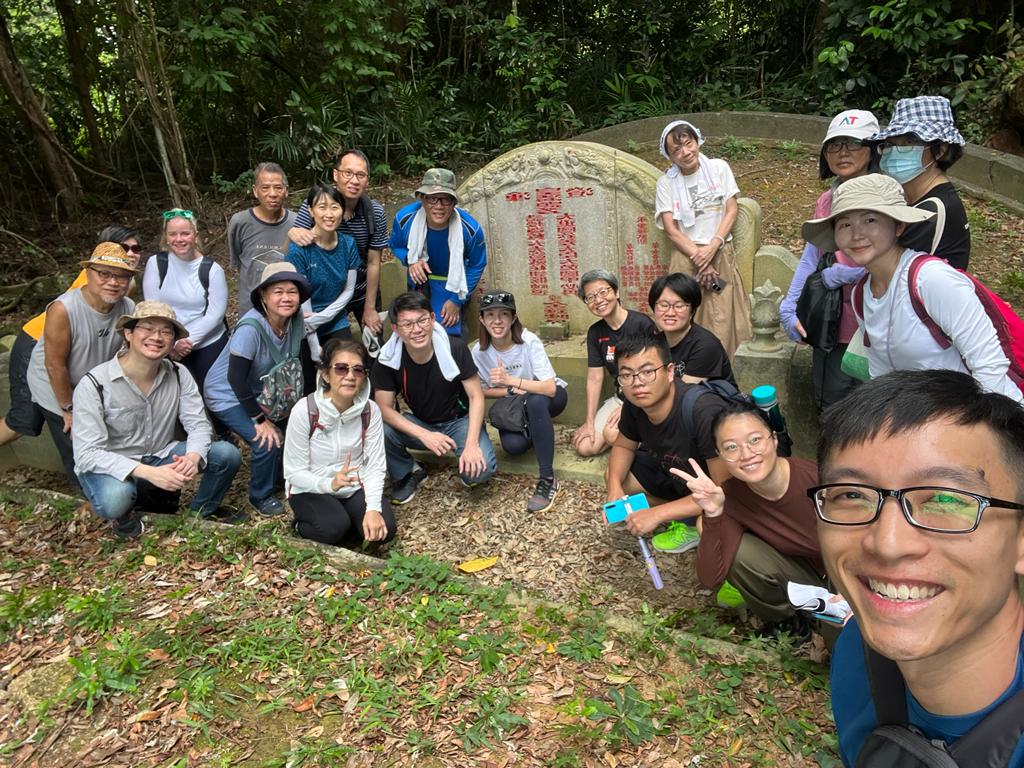
The grave of Tan Kim Ching. Kapitan Cina, Special Envoy in the Siamese court, scion of Tan Tock Seng
This blog post is extracted and adapted from a 2012 issue of Nature Watch. with thanks to the Nature Society of Singapore especially, Dr. Ho Hua Chew. Coming up “ The Spirit of Bukit Brown” by Ilsa Sharp.
She first visited Bukit Brown in early 2012 and came on a few guided walks conducted by the Brownies before naturally falling in step with the volunteers and started conducting guided walks in 2013. She has co curated a few themed walks such as the poetry walk, Botanic Gardens to Bukit Brown for Jane’s Walks, meet-up groups and always is among the first to volunteer when we get private requests including from the Peoples Association and constituency community grassroots groups who are caught by surprise not only that their volunteer is foreign but also speaks Mandarin!
Bianca traveled out of her birthplace Holland to the region when she was in her late twenties and she worked in Malaysia & China for a few years before finally ending up in Singapore where she has lived and worked for 16 years now. She knows more about Singapore’s heritage places and history than the average Singaporean and has embraced our cultural traditions, even demonstrating how to cook nasi ulam at the Baba House Museum.
Not surprisingly, the local television channel 8 which broadcasts in Mandarin featured her in their programme recently.Here is her appearance “live” when she was interviewed in the studio after the crew tagged her on a few visits all over Singapore.
http://www.channel8news.sg/news8/ca/hellosingapore/episodes/20160823-hs-high2/3066160.html
So the next time you come on a guided walk and Bianca is your guide, you can test her Mandarin! She also speaks Dutch (of course), French, German, Swedish, and gets by in understanding Latin languages.
Information on public walks in Bukit Brown can be found by following Bukit Brown Events on Peatix : http://peatix.com/user/617188/
=======
Footnote: Bukit Brown Cemetery is commonly known to the Chinese as Kopi Sua.
The news broke this morning and was headlined “The Outlook 15”
We are pleased to share breaking news that Raymond Goh has been shortlisted as the top 15 from among 50 inspiring individuals in their home countries nominated by listeners to “Outlook” – a weekly radio programme on the other BBC – The British Broadcasting Corporation aka The Beeb.
He sits in good company among indefatigable individuals who have survived against the odds and individuals who strive each day in challenging environments to make life a little better; from granting wishes to the terminally ill to being a voice for survivors of unspeakable tragedies; from Sierra Leone to our Singapore, where our nominee gives voice to the dead in order that our past has a future. The full report can be found here
The nomination was submitted at the end of April 2016 by A.J Leow.
In his submission to the BBC nominating Raymond Goh in under 200 words (the limit) he wrote:
The Bukit Brown Cemetery (BBC) was largely a forgotten site in urban Singapore until the government announced plans in 2011 to build an 8-lane highway across it and exhume for a start 4,000 graves. Raymond and his brother Charles then started to explore the site. They organized guided tours and were soon joined by more volunteers known as Brownies.
Raymond has since discovered more hidden tombs and linked many descendants to forgotten ancestors who include the real early pioneers who founded schools, banks, clan associations, public parks and lent their names to some 50 streets in Singapore. Besides his frequent sojourns to BBC in his trademark white towel and T-shirt, Raymond also combs newspaper, clan and other archives.
As a result of his research, the Brownies even got BBC listed on the World Monument list and was recognised as Advocacy Organisation of the Year 2014. Their efforts have inspired new heritage trails, award-nominated plays and new books — all thanks to our very own tomb whisperer (and Indiana Jones) who has inspired a revival of Singapore’s own history.
The news that the submission was accepted came by way of a feature interview on the BBC World Service radio programme, Outlook “They call me Singapore’s Tomb Whisperer” conducted at Bukit Brown with Raymond and his nominator. The recording can be found here
In sharing the news this morning that he had been shortlisted, Raymond posted on his FB page:
“From 50 to 15…..truly humbled and overwhelmed by this shortlist. I have all the Bukit Brown community volunteers and tombkeepers who have accompanied me on my journey for the past 10 years to thank. Without their encouragement, support and assistance, would not have walked so far. And of course my brother Charles, partnering me along the road ….”
For more on the passion and dedication of Raymond and Charles in uncovering our lost heritage, read The Goh Brothers – A Decade of Exploring, a decade of Sharing
Our best wishes and congratulations to Raymond, as someone posted, onward to the final 3.
In the early afternoon last Sunday (2 August, 2015) I dreaded my decision to go for a guided walk around Bukit Brown cemetery. However, I have promised my friends that I will turn up, so grudgingly, I made my way to the meeting point for the walking tour. Three hours and a lot of mosquito bites later, it is a decision that I did not regret.
Tombstones don’t lie. All aspects of the tombs – from the layout, the materials used, the carvings and statues around the tomb – give us snippets of information about the individuals and the Chinese immigrant community in early Singapore. The tour shed light on the stories of the individuals; after the tour, the occupants of Bukit Brown turned from random people to dignified individuals who made a difference to the social reality we experience today. Our history and social studies curriculum doesn’t do justice to the various individuals who made a difference to Singapore. While we know a significant bit about Tan Tock Seng, we overlooked the contributions of his eldest son, Tan Kim Ching, who is also buried in Bukit Brown. Tan Kim Ching not only participated actively in philanthropy, just like how Tan Tock Seng did, he also had a close relationship with the royal family of Siam (known as Thailand now), and played an important role in diplomatic relations between the Straits Settlements and Siam. It is also to my surprise that the 72nd generation of Confucius also set foot in Singapore, and is also buried in Bukit Brown cemetery *.
The diversity of the ‘residents’ of Bukit Brown was jaw dropping. Tombs of Hokkiens, Teochews, Cantonese, men, women, the rich and the poor can be found in Bukit Brown cemetery. A range of calendars was used in the inscriptions of headstones in documenting the time of birth and death of individuals. Some Chinese pledged allegiance to the Ming dynasty of China and at their time of death dreaded the fact that they would be buried in a foreign land, while others were content to call Singapore home and to be buried here. I saw for myself the intricate Peranakan tiles laying some of the tombs of wealthy Peranakan Chinese, who chose to be buried in Bukit Brown as they did not identify with their Chinese dialect clans. It was also fascinating to gain an insight on how the early Chinese viewed death – many of them viewed their tombs as their homes in afterlife, and the layout of the tombs resembled the layout of homes. Much thought was put into the building of tombs; some tombs had carvings transmitting values like filial piety, some had intricate statues symbolizing prosperity, fertility and abundance, while other had inscriptions revealing how they felt when they were buried in Singapore. The trip was especially meaningful for me, as a female.
I learned more about the contributions of early Chinese women to the cause of gender equality we have today. Ms Lee Choo Neo, the founder of a Chinese Ladies Association, lobbied for the right of females to live a more enriching life. The Association taught domestic skills, supported education for females, and sponsored a rescue home for women. She was in her teens when she started these big projects. She can be rightfully known as, according to my understanding, the grandmother of the civil society in Singapore. The experience exposed how much I didn’t know about the history of Singapore, beyond what was taught in our social studies and history textbooks. I was deeply humbled by the number of times I widened my eyes in surprise as the volunteer guides (Brownies) dropped nuggets of trivia about prominent early Chinese immigrants. There is just so much the cemetery revealed about who we are as Singaporeans before Singapore’s independence, and the place unjustified the sweeping claims about how Singapore is ‘cultureless’.
As we celebrate 50 years of Singapore’s independence, let us remember, as the guides rightly pointed out, that it is also our 70th year of liberation from the Japanese Occupation, and almost a century from the time we were first part of the Straits Settlements. It is my hope that the stories told during the tour are documented and made available to a wider audience, lest our social history be like those resting in Bukit Brown cemetery – buried six feet underground, never to be seen or heard by the future generations of Singaporeans.
*Editors Clarification: The 72nd direct descendant of Confucius had prepared his grave with the intention of being buried beside this wife who passed away before him, but he was buried at Bidadari instead. We thank Jiayi for taking time to pen her thoughts on her first visit to Bukit Brown and invite anyone who would like to contribute a blog post to write to a.t.bukitbrown@gmail.com. For information on guided walks please visit bukitbrown.com for weekly updates.
About Jiayi: Jiayi is a young Singaporean still in search of what makes her Singaporean. She is interested in issues relating to the Singaporean society as a whole, including social stratification, education and national identity.
*********************************************************
All Things Bukit Brown congratulates Raymond and Charles Goh who have been chosen by Chinese news daily Zaobao to be included in their list of Personalities of 2014. For the Brownies, it is a timely recognition for the 2 brothers who have been exploring and uncovering the “lost” heritage and history of Singapore since the mid 2000s. Their hard work, sheer doggedness in research and walking the ground, is our inspiration, and we are proud to claim them as Brownies and proud, we walk with them
===============================================
Translated Article by Raymond Goh
2014 Personality of the Year by Zaobao weekly, Dec 28, 2014
Raymond Goh (51) and Charles Goh (46), Looking at history through the departed
If not for praying to one’s ancestors, one would not usually go to the cemetery. That day the reporter asked a taxi driver to drive her to Bukit Brown cemetery. The driver was not very happy, and so she has to alight at approx. 200 metres from the cemetery at the road cross junction. But the Goh brothers does not have any sort of taboo. They keep on bringing people to the cemetery to look for their roots, rediscovering old tombs hidden in the depths of the forest, bringing history back to life.
Ever since Sep 2011 when news broke out that part of Bukit Brown has to give way to a road and approx 5000 tombs has to be exhumed, nearly twice a month during weekends and public holidays, one would see volunteer guides from all walks of life known as “Brownies” wearing Bukit Brown heritage T shirts, and guiding the public on the history and heritage of Bukit Brown.
Raymond and Charles Goh are a familiar pair among the Brownies and the pioneering guides among them.
Bukit Brown Pioneering Explorers
Charles Goh is a construction safety manager and has from young like to explore the unknown to get to the root of matters. Some things will be forgotten or disappear as one grow up, and Charles hope to revive the forgotten collective memories. Since the SARS crisis of 2003, Charles responded to the call of STB and together with his brother registered as tourist guides. They do voluntary guiding for visitors to the cemetery, and let these visitors know Singapore in an unique way.
Together with Raymond Goh, a pharmacist, they founded Asia Paranormal Investigators, as a step forward to fulfil their ambition to research all things unknown. Since 2006 they also started to lead tours to Bukit Brown, do research into tombs and even design a cemetery map for the public to do DIY tours on their own.
Raymond said that Bukit Brown and the surrounding Seh Ong and Hokkien cemeteries has a total of 200,000 tombs, with the earliest dating all the way to 1826. From that year to the closure of the cemeteries in the early 1970s, one can see 150 years of changes and transformations reflected through the tombstones of Bukit Brown. Our history is gathered piece by piece from the collective stories of all these tombstones.
2014 Great Finds
Through the efforts of Charles, Raymond and the Brownies, there has been a surge in interest to find one’s ancestor. Due to the passage of time and insufficient information, the success rate of finding one’s ancestor for these tombs is only about 50%, but the rediscoveries of pioneers’ tombs provide much encouragement to the Goh Brothers. This year alone, the two great finds are the founder of Hong San See temple Neo Jin Quee and the family cluster tombs of Lee Kuan Yew maternal ancestors.
According to the archives, Hong San See founder Neo Jin Quee was relocated to Bukit Brown cemetery. When Raymond Goh first encountered this tomb, he combined forces with local history researchers Walter Lim and Ang Yik Han to research into this tomb and finally confirmed the identity of this tomb. The discovery of Neo Jin Quee’s tomb and the tombs of his wife, son and daughter-in-law provide important clues to the study of the immigrant stories of early Lam Ann people to Singapore.
Apart from this, in Jun this year, a news report to find the rickshaw puller Koh Teong Koo made Raymond recalled about Lee Kuan Yew maternal grandfather Chua Kim Teng and maternal grandmother Leong Ah Soon. Based on the clue provided by tombkeeper Soh Ah Beng, Raymond and Walter Lim finally found the tombs of Chua Kim Teng, his second wife and his father’ tombs. They later managed to find Leong Ah Soon’s tomb from the burial register, that is Chua Kim Teng’s third wife. The Chuas were a typical Peranakan family, and Chua Kim Teng was a successful merchant. These finds provide important historical information for the study of this early Chua pioneer family.
Apart from graves, Charles Goh is also interested into heritage sites and ruins. Not long ago, together with NHB Group Director (Policy) Alvin Tan, they rediscovered a century old lunatic asylum wall, which provide valuable information for the study of this early institution.
The greatest difficulty in finding graves is not mosquitos and insects bites, nor wild snakes or animals, nor wild vegetation, but the limited information and resources to find the graves.
Although there are burial records in Bukit Brown, many descendants does not know the dates their ancestors passed away, and some can only remember their ancestors’ Chinese names, while the records are in English. The lesser the information, the more difficult will be the tomb find.
As such, Raymond said that sometimes it require more than the efforts of one or two persons, but the combined efforts and expertise of many volunteers to help find a tomb.
As for 2015, the Goh brothers will keep on their volunteer work of researching and finding tombs, and their mission is to find an earlier tomb than 1826 as there were already Chinese people then who died before that.
By Mok Mei Ngan
Catch a video of Raymond Goh on zaobao.com, sharing his interesting discovery of Bukit Brown Cemetery here
================================================
Zaobao weekly – 2014 Personality of the Year
They may not be famous people in the limelight,
But yet each in their chosen field give out their own light and heat and leave behind beautiful imprints in 2014
There is a Western proverb “The devil is in the details”, which means that it is in the details which spell success
These six personalities selected by Zaobao Now are chosen especially for their insightful analysis and acute observation, taking care of the whole situation, yet not leaving out the smallest details to ensure success for their endeavours
They are :
Two relatively unknown “amateur archaeologists” brothers Raymond Goh and Charles Goh who started to find old tombs to return back history. In this rapidly growing city of ours, they search for old tombs and uncover lost history. They also bring people to cemeteries to search for their roots and let the light shine once more upon the hidden tombs in the forest, bringing history back to life
Artist Ong Keng Seng who revamped the Singapore International Festival of Arts to reach out to a wider audience. His 12 chosen productions attracted widespread discussion
Chef Julien Royer from Swissotel Stamford Jaan restaurant for his passon in the culinary arts and for winning multiple culinary awards, and let foreigners look at Singapore food scene
Photographer Sim Chi Yin. Originally an ST correspondent based in Bejing, she give up journalism for photography, and use her passion for the lens to reflect Chinese mainstream society in China. In July this year She became the only Asian photographer to join the Internationally renowned VII Photo Agency. In Oct she was selected by Her World magazine as this year Young Woman Achiever
Christopher Lee Meng Soon for beig the first non-Taiwanese to win the Best Actor Award in the 49th Golden Bell Awards. His win means that the top awards coming from Taiwan for the Cinema, Music and TV all have been won by our local artistes, and mean that here we do have internationally recognized acting talents.
JJ Lin for winning the 25th Golden Melody Awards for best mandarin male singer. He also won two awards from the 19th annual Composers and Authors Society of Singapore (COMPASS) for top local artiste for the 6th consecutive time and best song writer for the 4th time
All Things Bukit Brown is pleased to announce that it is the first recipient of the Civil Society Advocate Organisation of the Year Award in the inaugural Singapore Advocacy Awards. This is our acceptance speech at the ceremony on August 30, 2014.
“We are honoured and humbled to have been deemed deserving to receive this award by a dedicated and diverse panel of activists, many of whom have worked tirelessly and for a much longer time on a variety of causes such as foreign worker abuse, AIDS awareness and education, the protection of women’s rights and the championing of the local arts scene.
While we are very much the “new kids on the block” among causes highlighted today, we have stalwarts before us who championed the cause of heritage preservation and protection. We look upon this award as encouragement and affirmation, that what we do in promoting awareness of the Habitat, Heritage and History of the iconic Bukit Brown Cemetery is contributing to the growing voices of concern about how rapid development has resulted in the loss of our old places and a growing sense of alienation of what is home.
Our encounters on the ground talking to and documenting stories from tomb keepers to descendants have been enriching, and our wider Bukit Brown experience has led us to places we have never been, to temples and other areas of cultural and ethnic significance, and in observing the customary rites and rituals which are being practiced today, and further afield to maritime port cities linked to our past. By celebrating the rich diversity of a shared past which is being kept alive by sheer dint of devotion and effort, we find ourselves sharing in a larger collective act of preservation of our culture and identity. We are far from alone.
In receiving the honour of this award, we pledge to continue to engage in conversation and in concert with all stakeholders to make heritage a part of the development paradigm, and to re-imagine spaces which will reinforce memory and identity from one generation to another generation.
We would like to thank especially Raymond and Charles Goh, for leading the way and sharing with us so generously and so passionately all your research from when both of you started exploring Bukit Brown eight years ago. Our abiding gratitude goes to the community especially on Heritage Singapore – Bukit Brown Facebook group which have encouraged and supported us, and which enlivens Bukit Brown daily with the members’ sharing of interesting articles and stories, anecdotes and sometimes grave discussions. It is your enthusiasm that led us all on this journey; unlike most online communities, we are glad to have met many of you face-to-face in on- and off- site events.
We thank the Singapore Heritage Society for nominating us and finally we thank the SAA for this honour, which we will endeavor to live up to. We have much to live up to.
We acknowledge and congratulate all the other nominees. For us, it was enough to have been nominated.
This initiative by SAA makes all of us nominees winners because it celebrates the acts and sacrifices made by volunteers across different communities. Volunteers are the heart of many communities, raising awareness, lifting spirits, affirming shared values, shaping aspirations, and connecting the different threads of society into a fabric that is stronger for weaving its constituents together. Volunteerism is often driven more by passion and purpose than resources, and demands us to be creative, persevering and collaborative. It is often, especially in the nascent stages, lonely and intimidating, confusing and almost crippling in the face of lofty expectations of what a few individuals can and should achieve.
We acknowledge and endorse the efforts of the SAA to bring voices to the communities that need encouraging, causes that need acknowledgement and affirmation, and issues that benefit from airing in public discourse. We do ourselves a service by taking ownership of issues and responsibility for making dreams a reality. This is our contribution to our society. It is humbling to be acknowledged.
Next year, we as a country will commemorate the 50th anniversary of the founding of Singapore as a republic, and the 70th anniversary of the liberation of Singapore from occupation during WWII. We salute all the communities and civil society activists before us who have taken our country to where it is today.”
Claire Leow & Catherine Lim, Co-Founders, All Things Bukit Brown
***

The Brownies with Constance Singam, one of the judges and a highly esteemed civil activist and writer
- T. Sasitharan (Panel Chair) – Arts educator and Cultural Medallion winner
- Cherian George – Academic
- Richard Ho – Architect
- Faizah Jamal – NMP & Environmental Activist
- Sharon Siddique – Consultant
- Constance Singam – Civil Society Activist and Writer
- Wong Ting Hway – Medical Doctor
- Geoffrey Yu – Arts Supporter and Former Diplomat
“Activism and advocacy are the cornerstones of an active and vital civil society movement and the need to establish and protect free space for civil society has never been more urgent than it is now,” said Mr Sasitharan. “A strong civil society will lead to healthy, functioning democracies. Conversely, healthy, well-functioning democracies must allow strong civil societies to exist.”
“If civil society in Singapore is to grow and mature, then it is crucial that good advocacy work that makes an impact on society, that is engaged with the community and that empowers people, should be properly recognised, acknowledged and applauded.” (Source: TOC article here)
The Honours List:
ACRES * All Things Bukit Brown * Braema Mathi * Chan Li Shan * Damien Chng * Eugene Tay * Jeremy Boo and Lee Xianjie * Louis Ng * M Ravi * Pink Dot
Advocate of the Year: Braema Mathi (President of Maruah, a human rights advocacy group)
Advocate of the Year: Louis Ng (ACRES – Animal Concerns Research and Education Society)
Advocacy Organisation of the Year – All Things Bukit Brown
Most Promising Advocate – Chan Li Shan (mental health advocate, author of A Philosopher’s Madness)
Most Promising Advocate – Damien Chng (We Believe in Second Chances)
***
The citation:
Postscript: It is worth mentioning that we acknowledged fellow nominee Eugene Tay, who supported us from the early days, and blogger Jerome Lim of The Long and Winding Road fame, for bringing us together. They inspired us in their railway walks, a precursor to the Green Corridor campaign.
We received the award from William Lim, one of the greatest honours we have experienced.
Lim Su Min, a Brownie and a descendent of Tan Tock Seng and Lim Boon Keng, sketched the historic inaugural awards:
Related Posts:
Bukit Brown named World Monuments Watch site
Preamble : Hungry Ghost Festival
Saturday, 26th July was the eve of what is popularly known as the Hungry Ghost Festival, and less well known by its traditional name of Zhongyuan Jie, which in essence is also about honouring ancestors. It takes place at the start of the Chinese 7th lunar month, and it is when the gates of hell open and the spirits of dead are free to wander among the living for a month. To appease them, offerings and entertainment is laid out by descendants at their homes, but also by temples, business and clan associations. This year, the prediction was that hell’s gates will open at 11pm on the eve of the festival.
The Salvation Rituals
At Bukit Brown, devotees from the Taoist temple Xuan Jiang Dian (Heng Kang Tian ) conducted a “chao du” or “salvation rituals” – considered an act of compassion – specifically for the forgotten and lost spirits there.
This is the 3rd year in a row, Xuan Jiang Dian have done this, ever since in fact news of the building of the highway across Bukit Brown in 2011 was announced. Exhumations of the some 4.153 graves which are in the way of the highway are drawing to a close. So there was added interest in this year’s ritual which was covered by our national newspapers. The National Heritage Board (NHB) shared that a specially commissioned video on rites and rituals at Bukit Brown will be uploaded soon to you tube.
A First Hand Account of “chao du”
The ” chao du” ceremony which was witnessed also by Brownies and other well wishers, started at around 8.3opm . It consisted of the setting up of an altar table with offerings at the major junction of the 4 roads in Bukit Brown which leads to Blocks 1, 5, 4 and 3.
The Taoist priests from China, resplendent in their robes, chanted and walked several ceremonial rounds in the area calling upon lost spirits. There was something soothing in their chanting and the air was redolent with the scent of what must have been a hundred lighted joss sticks. Each participant carried 3 sticks each throughout the 40 minute long chanting.
There was a stillness in the air and the smoke and swish of the robes carried the movement of the night. It ended with the burning of paper offerings and just as quickly as it was set up, the devotees packed up and left, with the the candles planted still burning and the last vestiges of the paper offerings smouldering down to embers.
******
Photo Gallery :

Side View : Off site 3 tablets, set up by Xuan Jiang Dian at Bukit Merah Blk 123 for the wandering spirits of Kopi Sua aka Bukit Brown. [right] for animals killed during agricultural activity (prior to it becoming a cemetery)[centre] for wandering souls[left] for animals killed during construction works (photo and caption by Chua Ai Lin)
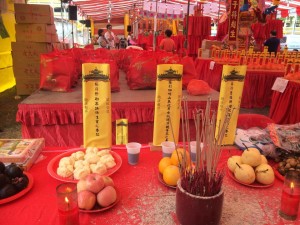
Front View : Off site 3 tablets, set up by Xuan Jiang Dian at Bukit Merah Blk 123 for the wandering spirits of Kopi Sua aka Bukit Brown. [right] for animals killed during agricultural activity (prior to it becoming a cemetery)[centre] for wandering souls [left] for animals killed during construction works (photo Raymond Goh)
Report on Lianhe Zaobao on a ritual conducted last night at Bt. Brown which marked the opening of the 7th month: A group from Heng Kang Tian including 8 Taoist priests conducted the ritual to invite spirits to a salvation ceremony conducted today in front of Bukit Merah View Block 123. The group has been going to Bt. Brown for the past two years to invite spirits from tombs which are not tended to by descendants. The event was attended by Brownies and participants of tours at the cemetery. It was also recorded by the Bt Brown Documentation Team. NHB is currently preparing a 10-15 min documentary on the rituals carried out at Bt Brown cemetery. This will be uploaded to the NHB channel on youtube, “yesterdaysg”, around end next month. (summary by Ang Yik Han) Full report in Chinese:
文物局到武吉布朗坟场 记录“招魂”仪式
王舒杨
联合早报2014年07月27日
今天是农历七月初一,华人传统节日“鬼节”今起开始。昨晚,武吉布朗坟场文史记录小组和国家文物局人员特地到武吉布朗坟场,记录一场由道教团体进行的祭祀仪式。
昨晚约9时,应道教宗教团体玄江殿邀请的八名道长和一名唢呐乐师在武吉布朗坟场进行“招魂”仪式。在道路两侧点亮“引魂”的香火后,他们在锣鼓声中唱诵经文。今明两天他们将在红山景第123座前的道场举行大型超度法会。
数十名积极参与保护武吉布朗文化遗产的公民团体成员也到场目睹仪式。除了这些“武吉布朗人”,不少报名参加坟场导览活动的外国人和游客也纷纷拿起相机拍下这个独具特色的活动。
玄江殿自1996年起多次在武吉布朗坟场举行农历十月初一的“寒衣节”祭祀活动,并从两年前开始在武吉布朗坟场举行七月鬼节的法事,目的是在坟场进行招魂,为他们超度。
根据武吉布朗坟场文史记录小组整理的资料,武吉布朗坟场里的中元节如同一项社区活动,是一种灵界上的慈善事业。信徒所祭祀的亡魂通常与他们没有任何亲属关系,尤其是孤魂。
玄江殿主持陈荣兴(45岁)说,武吉布朗一些坟墓主人没有子孙祭拜,所以希望能为这些孤魂超度。
此外,道家也相信所有生灵皆可超度,而坟墓挖掘过程中伤到蚂蚁等生灵,超度法事也怀有对它们的尊重。
国家文物局目前正在筹备一个10至15分钟长的纪录片,介绍华人社群在武吉布朗坟场的仪式,包括七月鬼节、清明节以及较少人知道的寒衣节。短片料下月底上载到文物局的YouTube频道“yesterdaysg”。
文物局总司长(政策)陈子宇说:“武吉布朗坟场不仅仅是一个埋葬地点,也是华人社群进行祭祖等仪式的地方。我们会记录这些仪式,以继续丰富我们有关新加坡非物质文化遗产的数据库。”
公众可通过在国家图书馆大厦9楼展出的“武吉布朗:记录新知识 开拓新视野”中英文展览,了解武吉布朗坟场上世纪的演变、坟墓设计和民间风俗等。图书馆大厦展览在10月10日结束后,将陆续在宏茂桥、裕廊、蔡厝港和大巴窑图书馆展出至明年1月底。
A postscript : Saturday 2 nd August, descendants are brought to visit the cluster of tombs belonging to Chua Kim Teng, Seow Geok Luan and Chua Eng Cheong by Raymond Goh
“Touching and joyous moments as descendants of Chua Kim Teng’s family pay respects to their ancestors for the first time. Even the ground was pulsating with energy as my compass luopan went haywire” Raymond Goh.
***
Today’s Chinese newspaper Zaobao, reported on a significant find of Lee Kuan Yew’s maternal ancestry in the depths of the forest of Bukit Brown. It is the find of the year (2014) for Bukit Brown researchers and bloggers Raymond Goh and Walter Lim.
Please click on image to enlarge
“The 4 related tombs ranging from 70 to 127 years in Bukit Brown and Greater Bukit Brown (Lao Sua) has been rediscovered by local historical researchers and are valuable resources for the study of our founding Prime Minister Lee Kuan Yew’s maternal grandfather, Chua Kim Teng family history “
The find was discovered on 1 st July. From photos sent to Raymond by a tomb keeper in the area, Raymond subsequently on the same day, verified it on site as belonging to Lee Kuan Yew’s family. The find was kept under wraps to allow Zaobao correspondent Chia Yen Yen, time to conduct further research with family members of Lee Kuan Yew, specifically his brother, Dr Lee Suan Yew contributed this family photo to the article.
The 4 tombs were identified as belonging to Chua Kim Teng and his two wives Seow Geok Luan and Leong Ah Soon, and Lee Kuan Yew’s maternal great grandfather Chua Eng Cheong. They are from Lee Kuan Yew’s mother side ie Mrs Lee Chin Koon nee Chua Jim Neo. Leong Ah Soon’s grave is situated in Bukit Brown Cemetery, the other three are situated close together in a family cluster in Lao Sua Hokkien Cemetery which is located in the hill known as Bukit Brown in old maps. Lau Sua Hokkien Cemetery is adjacent to Bukit Brown Cemetery.

Chua Kim Teng (LKY’s maternal grandfather – centre row, 4th from left), Leong Ah Soon (centre row, 4th from right) Lee Kuan Yew’s mother Chua Jim Neo (centre row, 2nd from left) and her brother Chua Kheng Hoe (last row, second from left) was also related by marriage to Lee family (Family Photo from Lee Suan Yew)
This extended family portrait was taken at 92 Kg Java Rd bungalow where Lee Kuan Yew was born.
Additional info on the house: The Cheng Kee Hean Association celebrated its silver jubilee in June 1918 with the taking of group photograph and a thanksgiving ceremony at the house of Mr Chua Kim Teng (vice-president) in Kampong Java Road.
The link to the FB posting by Raymond Goh when he first identified the tombs here (only accessible if you have a facebook account)
“The inscriptions also attest to the rich burial Chinese culture and customs being practiced in Bukit Brown cemetery. As the dragon dance and flag beats, the gates of Heaven are opened (Chua Eng Cheong’s tomb inscriptions)” Raymond Goh
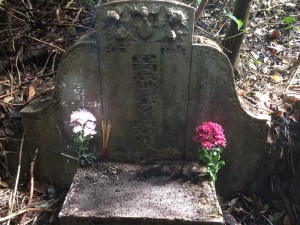
Mdm Seow Geok Luan’s tomb (Chua Kim Teng”s wife), with tomb design 五蝠 (福) 捧壽 five bats (homophonic with fortune) encircling longevity (photo Raymond Goh)
****
Translation of Zaobao Article
The tombs of Chua Ying Chiang and son Chua Kim Teng were rediscovered by local history researchers, Raymond Goh and Walter Lim. Although they have seen the tombs before, it left no earlier impression on them until a news report about the rickshaw puller who saved Lee Kuan Yew’s life emerged recently. Raymond then remembered, Lee Kuan Yew had mentioned his maternal grandfather Chua Kim Teng and grandmother Leong Ah Soon in his memoirs. Coincidently at the same time, Soh Ah Beng, a tomb keeper had used his mobile phone to take a photo of the tombstone and forwarded it to Raymond who later confirmed that the tombs belong to the ancestors of the Chua family.
Zaobao correspondent, Chia Yen Yen together with Raymond Goh and Walther Lim specially made a trip to the deep forested area of Bukit Brown known as “Lau San”, meaning old hill to substantiate the find. They also discovered the tomb of Chua Kim Teng’s second wife, Seow Geok Luan next to Chua Ying Chiang (Chua KimTeng’s father). However, the tomb of Lee Kuan Yew’s maternal grandmother, Leong Ah Soon was missing. On conducting further research and the Bukit Brown’s burial register, they finally located the tomb of Leong Ah Soon.
Two descendants of the Chua family, retired accountants, Seet Keong Fatt and Seet Keong Hoe, told Zaobao, that every year during “Ching Ming”, they would visit their maternal grandmother, Leong Ah Soon’s grave to pay their respects. However, they were no longer aware of the whereabouts of their maternal grandfather and great grandfathers’ graves. The mother of the two Seet brothers, Chua Swee Neo is the the youngest daughter of Chua Kim Teng and Leong Ah Soon. Chua Swee Neo is also the younger sister of Chua Jim Neo (Lee Kuan Yew’s mother). She had married Seet Cheng Kang in a traditional Chinese wedding ceremony in 1937 and their wedding was reported in the press.
Based on the “Memoirs of Lee Kuan Yew”, for a married daughter’s family to live with the in-laws (as was the case for Lee Chin Koon and Chua Jim Neo living with the Chuas) was not accepted in a traditional Chinese family. But to a Chinese Peranakan family from Malacca it was common.
Although Chua Kim Teng was born in Singapore, his father Chua Ying Chiang came from a typical Peranakan family in Malacca. Chua Ying Chiang’s tomb at the 127 year old “Lau San” of Bukit Brown is very large, estimated to be 40 feet in length and 24 feet in width, reflecting on his illustrious life. However, it is a pity that what information about his life that can be found today is limited.
Chua Kim Teng’s second wife, Seow Geok Luan’s tomb is next to Chua Ying Chiang, and much smaller.
According to the old map, the 3 tombs are at the “Lau San” of Bukit Brown.
The inscription on Chua Ying Chiang’s tombstone recorded his death date as April 1887. On the tombstone are carvings of dragons, unicorns, cranes and deer. This reveals the beliefs and importance placed on the “dragons’ veins” and “fengshui” meaning posterity and prosperity.
The other couplets are “龙挺旗鼓天门开、虎拒艮宫地户闭and “排衙之砂真有情、癸向艮流富贵龙” which translates to : “As the dragon dance, and the flags beat, the gates of heaven are open. The surrounding terrain gives support, and prosperous and illustrious the dragon becomes”
The names of Chua Ying Chiang’s son, Chua Kim Teng and daughters: Beow Neo, Tam Neo and Cheng Neo are inscribed on the tombstone. However, based on family tree records, the names of the other two sons, Kim Tiong and Kim Tye are missing from the tombstone.
Chua Kim Teng (1865-1944) outlived his 3 wives. On his tombstone are names of 6 sons and 8 daughters. However, the name of his adopted son, Keng Seng (adopted by wife Leong Ah Soon) was omitted. His other 2 daughters, namely Sim Neo and Siew Neo were also omitted. There is a possibility that that the names of his descendants were copied from the tombstone of his second wife, Seow Geok Luan which explains why the 2 youngest daughters’ names were omitted.
According to Dr Lee Suan Yew, both his paternal grandfather, Lee Yun Long and his maternal grandfather, Chua Kim Teng died during the Japanese Occupation. He was 11 years old when his maternal grandfather passed away and he still remembers his mother Chua Jim Neo making arrangements for his grandfather’s funeral and burial.
Chua Kim Teng was born in 1865 and died in 1944 . As recorded on his tombstone, his ancestors are from Fujian, Zhangzhou, Haicheng, Zhen village (福建漳州海澄陈莊).
Dr Lee Suan Yew has the impression that his maternal grandfather was wealthy, lived in a big house, was generous and often gave his grandchildren money to buy preserved olives, sour plums and other snacks. He said that his brother Lee Kuan Yew was born in his maternal grandfather’s 2-storey bungalow at No. 92 Kampong Java. He has an old photo of the family, including his mother, maternal grandfather and grandmother, aunties and uncles, taken in front of the big bungalow.
The Chua family later moved to another big house at Lorong L, Telok Kurau. Based on a “For Rent” advertisement in the Straits Times dated 28 July 1928, the bungalow at Kampong Java had water and gas supply, telephones lines, a garage and a tennis court. It was a magnificent bungalow.
Dr Lee said that his maternal grandfather had three wives. First wife, Seow Chue Luan and second wife, Seow Geok Luan are sisters. His maternal grandfather had one son and 3 daughters with his first wife and 2 sons and 3 daughters with his second wife. He had 3 sons and 4 daughters with his third wife.
Based on records in the “Memoirs of Lee Kuan Yew”, Leong Ah Soon was a Hakka woman from Indonesia. She was a young widow with 2 young children. Lee Kuan Yew’s mother, Chua Jim Neo is the eldest daughter of Chua Kim Teng and Leong Ah Soon.
According to Dr Lee, besides the Kampong Java and Telok Kurau bungalows, his maternal grandfather owns several properties at Claymore Road. The properties were subsequently sold due to the Great Depression.
Based on old newspaper records, Chua KimTeng was the owner of a market at East Coast. Lee Kuan Yew in his memoirs mentioned that his maternal grandfather owned a large rubber plantation and the family sometimes took the bullock cart to the plantation for vacations.
Although Chua Kim Teng was a successful businessman, he was only actively involved in the mutual aid organisation Cheng Kee Hean Association which was founded in 1893. In November 1921, on the 25th anniversary of the association, a celebration dinner was held at the Kampong Java bungalow. Chua was then the Vice President of the association.
The tombstone of Lee Kuan Yew’s maternal grandmother, Leong Ah Soon is on a hillside of the Bukit Brown cemetery. Although the tombstone is not considered big, neither can it be considered small and is well kept. According to records in “Memoirs of Lee Kuan Yew”, Leong Ah Soon had 9 children. However, on her tombstone inscribed were the names of 7 sons and 10 daughters, a total of 17 children. There were also names of 7 grandsons and 6 granddaughters.
According to Dr Lee Suan Yew, the name of Leong Ah Soon’s adopted son, Chua Keng Seng (formerly Tan Keng Seng – son of sworn sister) was also inscribed on the tombstone. Leong Ah Soon’s daughter, Watt Neo is from her previous marriage. The names of Leong Ah Soon’s sons and daughters which were inscribed on her tombstone include the children of Chua Kim Teng’s first and second wives.
It is interesting to note that the couplet “源前皆赤子,益上是青天” on the tombstone has been amended and it differs from the original couplet “眼前皆赤子、头上是青天” which refers to court officials who are impartial. Does it imply that she treated all her children equally? Another couplet reads“自得山中趣,谁论世上名”. It literally translates to “when you know the pleasures of the hills , who cares about fame in one’s lifetime”.
Not only did Leong Ah Soon marry her daughter, Chua Jim Neo to Lee Kuan Yew’s father, Lee Chin Koon, she also took Lee Chin Koon’s sister, Lee Kim Neo as the bride for her eldest son Chua Keng Hoe.
Lee Kuan Yew, in his memoirs, said that his maternal grandmother had a different view on his education. His maternal grandmother had insisted on sending the young Lee Kuan Yew who was barely 6 years old to a private class in an attap house to learn and recite the Chinese Classics. When he complained to his mother about the difficulties he had learning Chinese, his mother pleaded with his maternal grandmother on his behalf to let him discontinue Chinese lessons. However, his maternal grandmother insisted that he learned some Chinese and transferred him to a private school in Joo Chiat. The school was impressive with 10 classrooms and had between 35 to 40 students per class. The young Lee Kuan Yew still had difficulties learning Chinese. Three months later, Lee Kuan Yew’s mother again pleaded with his maternal grandmother who finally agreed to let him transfer to an English school.
Based on records on Leong Ah Soon’s tombstone, she died on October 9, 1934. She was born in 1881 and was 16 years younger than her husband, Chua Kim Teng.
Based on archival records, Leong Ah Soon had on the eve of World War I, in 1916, with the joint effort of women in Malaya purchased fighter jets as gifts for the British government. She had donated ten dollars.
(Thanks to Elaine Tan for the translation with inputs from Raymond Goh)
李光耀外家先人四古墓密林中寻获
谢燕燕
2014年07月29日
苏亚明、吴安全和李志强(左至右)摄于建国总理李光耀曾外祖父蔡应昌的墓前,这个藏在深山老林的古墓已有127年历史。(严宣融摄)
新恒山亭与武吉布朗四座有70年至127年历史的老墓,最近被本地文史工作者重新发现,成了研究建国总理李光耀外祖父蔡金鼎家族的重要史料。
李光耀的曾外祖父蔡应昌、外祖父蔡金鼎和蔡金鼎第二任妻子萧玉銮的墓,多年来深藏在新恒山亭的深山老林里。蔡金鼎的第三任妻子,也是李光耀的亲外祖母梁亚顺则葬在武吉布朗坟场内。
这四座能为蔡家的家族史提供珍贵史料的老墓,是在本报于6月29日刊登了李光耀与人力车夫高长古的故事后,被本地著名寻墓人吴安全和文史工作者林志强找到的。
谢燕燕 报道
chiayy@sph.com.sg
蔡应昌、蔡金鼎父子的墓,吴安全其实过去见过,但没多加留意,也不清楚墓主人身份,直到阅读了本报《寻找人力车夫高长古》一文,才想起建国总理李光耀在回忆录中提到的外公蔡金鼎和外婆梁亚顺。
更巧的是,他的朋友苏亚明(51岁)正好在那个时候用手机,把蔡应昌墓和蔡金鼎墓的照片传给他,马上引起了他的兴趣。专门帮人打理墓园的苏亚明,从小在陈 牛廊(武吉布朗昔日村子)长大,对新恒山亭和武吉布朗了如指掌。他认识吴安全后,每次发现大型古墓,就会拍照传给吴安全看。
古墓藏在密林里
本月中的一个早上,本报记者随吴安全、苏亚明和林志强走入被喻为“老山”的新恒山亭后,发现蔡应昌、蔡金鼎和萧玉銮的墓确实藏在人迹罕到的密林里,蔡家后人恐怕早已找不到那里。苏亚明是因为经常在山里走动,加上他曾祖父的墓刚好与蔡金鼎墓为邻,才会发现这一组古墓。
吴安全、林志强找到蔡家三位先人的墓后,发现李光耀外婆梁亚顺的墓不在其中,于是翻查旧档案,通过下葬记录册找到她位于武吉布朗的墓。
本报后来走访李光耀的弟弟李祥耀医生,从李医生那里拿到蔡家后人所整理的一份简单家谱,再把这家谱与墓碑上的名字对比,理出了一个头绪来。
蔡家另外两位后人,退休会计师薛强发和薛强和告诉本报,他们每年清明都会到外祖母梁亚顺的墓拜祭,但早已不清楚外祖父和曾外祖父的墓在哪里。如今被重新发现,他们将找时间到坟前祭拜。
这两兄弟的母亲蔡修娘是蔡金鼎与梁亚顺所生的最小女儿,即李光耀母亲蔡壬娘(又作任娘,过去译成认娘)的妹妹。蔡修娘是在1937年与薛清江举行华人婚礼,当时还上报。
李光耀曾外祖父百年古墓极大
《李光耀回忆录》中说,在传统华裔家庭里,结了婚的女儿与丈夫、孩子若住在外家,通常不为社会所容,但对来自马六甲的土生华人家庭来说,这却是常有之事。
能找到的资料很有限
蔡金鼎虽是在新加坡出世,他父亲蔡应昌却是来自马六甲的土生华人,他们可说是典型的峇峇家庭。蔡应昌位于新恒山亭的127年古墓非常大,估计长40英尺,宽24英尺,显示他生前显赫,只可惜今天能找到的资料很有限。
蔡金鼎和第二任妻子萧玉銮的墓就在蔡应昌墓旁边,但规模小得多。
根据旧地图,这三座墓所处的位置就在原来的布朗山。
蔡应昌墓碑上记录着他是在“光绪丁亥年岁次梅月吉旦”即1887年4月去世,碑上面有朱雀浮雕,墓肩有龙的雕刻,供桌下有麒麟、仙鹤和鹿的图案。
墓前对联则显示这是很讲究龙脉与风水的古墓。里头的对联写着“龙挺旗鼓天门开、虎拒艮宫地户闭”,外面的对联是“排衙之砂真有情、癸向艮流富贵龙”。
蔡应昌的墓碑上刻着孝男金鼎和孝女妙娘、淡娘和贞娘,不过蔡家后人所整理的家谱则显示他还有另外两名儿子蔡金忠和蔡金泰。他们的名字为何不在墓碑上则不得而知。
比三名妻子长寿的蔡金鼎(1865-1944),墓碑上刻着六男八女的名字,当中少了梁亚顺所领养的敬成,却不清楚为何还少了两名小女儿心娘与修娘的名字。一个可能性是刻碑文时“抄袭”萧玉銮的碑文,以致漏掉两名小女儿。
萧玉銮是在中国刚“变天”,辛亥革命推翻满清王朝之际离开人世的。她逝于“辛亥十月十六日旦”(1911年12月6日),孙中山当时正从美国回返中国途中,所搭乘游轮一个多星期后抵达新加坡,他还在陈武烈位于花芭山腰的金钟别墅住了一晚。
中国是在1912年1月1日才改年号为民国元年,但萧玉銮的墓已率先启用民国年号,只不过当时情况有点混乱,把国号、年号颠倒用,以致出现“中华辛亥十月十六日旦”和“民国故妣谥玉銮萧氏墓”。
李光耀在外公别墅出世
李祥耀医生说,他祖父李云龙和外公蔡金鼎都是在日本占领新加坡期间离开人世。外公去世时他11岁,至今还记得母亲蔡壬娘操办丧礼的情景。
生于1865年,卒于1944年的蔡金鼎,墓碑上的祖籍是福建漳州海澄陈莊。
在李祥耀印象里,外公相当有钱,住在很大的房子里,为人很慷慨,经常给孙子们钱去买橄榄、酸梅等零食。
洋房很有气派
他说,大哥李光耀是在外公位于甘榜爪哇92号的两层楼别墅出世的,他至今还有一张旧照片,是他外公、外婆、母亲、众多阿姨和舅舅们在那栋大房子前拍摄的全家福。
蔡家后来搬到直落古楼罗弄L的另一栋大房子。根据1928年7月27日刊登在《海峡时报》的一则出租广告,甘榜爪哇的别墅有煤气、水、电话、车库和网球场,是很有气派的洋房。
李医生说,外公娶过三名妻室,第一任妻子萧翠銮和第二任妻子萧玉銮是姐妹,他和萧翠銮生了一男三女,和萧玉銮育有二男三女,和第三任妻子梁亚顺生了三男四女。
根据《李光耀回忆录》的记载,梁亚顺是来自印度尼西亚坤甸的客家妇女,嫁给蔡金鼎之前是育有两名年幼孩子的年轻寡妇。李光耀的母亲蔡壬娘是她与蔡金鼎所生的长女。
李医生说,外公除了拥有甘榜爪哇和直落古楼的洋房,还曾买下克雷摩路(Claymore Road)的好多栋房子,但后来受到经济大萧条影响而将之变卖。
林志强找到的旧报章资料显示,蔡金鼎曾是东海岸巴刹的业主,李光耀在回忆录中则曾提到外公在菜市拥有大片树胶园,他们家有时会坐牛车到园丘度假。
蔡金鼎虽是成功商人,但从旧档案看,他只活跃于1893年创立的互助组织正气轩(Cheng Kee Hean Association)。1921年11月,这个组织庆祝25周年时,曾在蔡金鼎上述甘榜爪哇别墅举行盛大庆祝会,他当时任正气轩副会长。
外婆梁亚顺坚持
要李光耀读中文
李光耀外婆梁亚顺的墓,坐落武吉布朗半山腰,不是很大,却也不小,维持得相当好。根据《李光耀回忆录》,梁亚顺生过9名儿女,但墓碑上却刻着7名孝男和10名孝女,共17名儿女的名字!另外还有7名内孙和6名内孙女。
李祥耀医生说,外婆墓碑上的一名儿子蔡敬生其实是她结拜姐妹的儿子,本姓陈,后来被外婆领养。另一名女儿发娘(也有写成活娘)则是梁亚顺与前夫所生女儿。梁亚顺墓碑上的众多儿女,包括蔡金鼎与两位萧氏所生儿女。
最有意思的是墓前的对联,把原本指为官清廉的“眼前皆赤子、头上是青天”改成“源前皆赤子,益上是青天”。这是否在比喻她公平对待众多儿女,把他们视为“赤子”?另一对联是“自得山中趣,谁论世上名”。
梁亚顺与蔡金鼎除了把女儿蔡壬娘许配给李光耀的父亲李进坤外,还让两人所生的大儿子蔡敬和迎娶李进坤的妹妹李金娘。
李光耀在回忆录中说,这位外祖母对他的教育很有一套看法,还不满6岁便坚持把他送到设在亚答木屋内的私塾,老师每天让孩子背诵古书。
他向母亲诉苦后,母亲代他向外婆说情,但外婆坚持他一定要读些中文书,于是送他到如切台浚源学校。这学校设施像样多了,有10间课室,每班35至40名学生,但年幼的李光耀还是觉得华文难学。两三个月后他再向母亲恳求,这一次外祖母终于答应让他转到英校。
根据坟墓上的记录,李光耀这位坚持要他读点中文的外婆是在民国二十三年九月初二,即1934年10月9日与世长辞。她生于1881年,比蔡金鼎小了16岁。
从旧档案中还知道梁亚顺曾于1916年,即第一次世界大战前夕,联合其他马来亚妇女购买战机送给英国政府,她当时捐了10元。
本报后来走访李光耀的弟弟李祥耀医生,从李医生那里拿到蔡家后人所整理的一份简单家谱,再把这家谱与墓碑上的名字对比,理出了一个头绪来。
新加坡报业控股版权所有(公司登记号:198402868E)
Bukit Brown : Documenting New Horizons of Knowledge
Location: NLB 9th floor from now until 10 October’14 and thereafter it will travel to other regional libraries.
The exhibition was officially opened on Saturday 19 July,2014 by MOS (Ministry of National Development) Desmond Lee.
It represents almost one and half years of research and working the ground documenting some 4,153 tombstones which are affected by the building of a new highway across Bukit Brown, by a team under the leadership of Dr. Hui Yew-Foong, an anthropologist with ISEAS.
We have observed the team hard at work over these years, joined some of them during Qing Ming and exhumations as observers and friends of the family of descendants, and the exhibition is a comprehensive and compact expression of what they have uncovered, shared with the public with insight and interesting artefacts , enhanced by new technology. We recommend it as a “must see” and “ground breaking” for insights shared of customary practices and traditions of burial customs and respect for ancestors.
An extract from the media release:
Documenting New Horizons of Knowledge” assembles a diverse range of documents,maps, photographs and objects to demonstrate how a cemetery can open a window to Singapore’s historical past and cultural present. Through a multi-disciplinary approach employing cutting-edge methods, techniques and technology, the exhibition will bring to the fore new horizons of knowledge unveiled through the documentation of Bukit Brown.
The exhibition opens with the origins of the cemetery, as a project of the Municipal Commissioners in early 20th in 1973, will be illustrated through maps and aerial photographs. Next, through explication of tomb inscriptions, tomb typology and the material culture of the cemetery, the exhibition will demonstrate Singapore’s connectivity to the region, China and the world.
While the cemetery is a burial space for the dead, it is also a space for the living at different points of Singapore’s history and ritual calendar. This will be illustrated through the life of kampongs that used to be situated in the vicinity of the cemetery and the life of the cemetery during Qing Ming and the Seventh Month Hungry Ghost Festival.
As data for the graves was collected and organised within a Geographic Information System (GIS) framework, the exhibition will present a Centrepiece where visitors will be able to access data related to specific graves through a map-based database on a touch screen monitor.
Finally, visitors will get a glimpse behind the scenes of documentation work, to get a sense of the different methods, techniques and technologies that were employed in the course of documentation. These range from balloon photography to 3D scanning, from interviewing to filming, and from the work of architects to the work of archaeologists.
****
Highlights of the Exhibition Opening
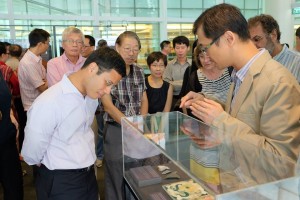
Dr Hui Yew-Foong, explaining material culture to MOS Desmond Lee during the curator’s walk through (photo Ang Hock Chuan)
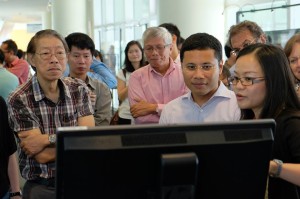
Dr. Natalie Pang (NTU) who worked on the IT applications for the centerpiece map demonstrating how it works to MOS Desmond Lee (photo Ang Hock Chuan)

The urn which used to house re-interred remains from other cemeteries to Bukit Brown (photo Raymond Goh)
This urn was used to re-inter bones exhumed from an older cemetery. It was from the grave of Madam Khoo Siok Hui, who died in 1836. Her grave was the oldest among those documented at Bukit Brown. Madam Khoo and her son Chee Yam Chuan were among the early settlers of Singapore. Mr Chee later returned to Malacca and made his fortune in tin mining in Selangor. Today, the Chee Yam Chuan Temple Trust continues to flourish in Malacca and Madam Khoo’s ancestral tablet can be found in the temple. The story behind this family shows the close links between Malacca and Singapore in the early years. It was Raymond Goh who first deciphered the inscription and unraveled the connection.

Treasure trove of jade bracelets worn by the women and traditionally buried with their wearers. (photo Ang Hock Chuan)
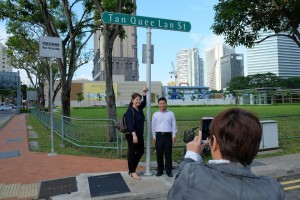
Descendant Serene Tan of pioneer Tan Quee Lan, gets one for the album when MOS Desmond Lee sportingly agrees to walk with her to visit her “great great grandfather’s road” ( photo Ang Hock Chuan)
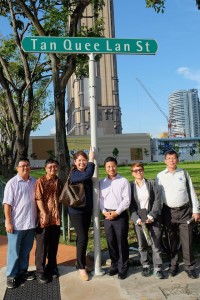
They were accompanied by a entourage of brownies who have been sharing Serene’s journey of reconnecting with her ancestors since Raymond Goh found the Tan Quee Lan cluster re-interred from another cemetery at Bukit Brown (photo Ang Hock Chuan)
A video at the exhibition features Serene Tan and her family observing the first Qing Ming at Bukit Brown in 2012 after Raymond Goh discovered the cluster of Tan Quee Lan tombs, and shows how the cluster underwent a renovation makeover by Serene and her cousin LT Tan who met at Bukit Brown itself. Serene’s story can be read here
The cluster is not affected by highway.
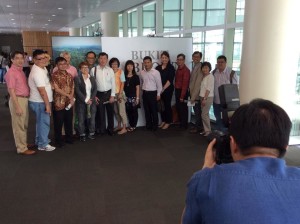
Brownies, academics, descendants, members of the documentation team at the exhibition (photo Khoo Ee Hoon)
“….to everyone who came and supported the launch, and most importantly, supported us and helped us generously with our research over the last 33 months. One of the purposes of the exhibition is to acknowledge all your contributions and I hope it accomplished that.” Dr Hui Yew- Foong, Curator of Exhibition on a FB posting.
Look out for 2 specially curated walks by the Brownies in conjunction with the exhibition in August (English) and September (Mandarin).
Photos taken of the exhibition courtesy of Brownie Ang Hock Chuan on Facebook here
Read more about the exhibition by the Rojak Librarian here
In a report, published on Sunday, 22 June, 2014, Bukit Brown emerged as among the top 3 sacred sites in Singapore, voted by readers in a Straits Times poll.
On learning of the news, Claire Leow, co founder of All Things Bukit Brown reflects:
“To see the Singapore Heritage Society recognised is most apt, for they sparked the civil society response back in November 2011.
To see the Brownies identified as a group is itself moving, as this disparate group of volunteers, heritage enthusiasts and selfless sharers of knowledge and skills has been utterly inspiring. You don’t get more organic than this community, active on site, offsite, beyond keyboards and in cyberspace. Hats off to sifu Raymond Goh and Charles Goh for their inspiration.
And to see others rally behind the Brownies, to cheer us on, to lift us up when we are down, to join us when we utter the rallying cry to stand up and be counted, to share sunny weekends and stormy ones at Bukit Brown, and just patiently adding to the knowledge we are just uncovering day by day, gently correcting our mistakes, boldly stepping in with expertise, shaping the very history of this campaign. Amazing. Very moved……”
Bukit Brown – one of the three sites Singaporeans voted as a sacred place.
******
The overgrown graves stretching for 200ha bang amid the city bustle make for a restful, peaceful spot rare in urban Singapore.
But when Bukit Brown Cemetery was slated for redevelopment for roads and residential buildings, it was more than its lush beauty that resulted in that rarity in Singapore – vocal protests to preserve it.
The site tugged at Singaporeans’ heartstrings, being the resting place of many forefathers of the country, a living repository of the Chinese diaspora’s tomb culture and design, and where descendants today visit for traditional rituals such as tomb sweeping.
Two civil societies – the Singapore Heritage Society and heritage enthusiasts who dub themselves “the Brownies” – organised petitions and embarked on efforts to document tombs.
No substantial concessions were made by the Government, however, to save the site from an eight-lane road running across it. It is also slated for residential development beginning with its southern portion.
Yet, it’s among the top three sites that Singaporeans deemed as “sacred” places in a recent Straits Times poll.
The poll itself followed a call by academic Kishore Mahbubani, dean of the Lee Kuan Yew School of Public Policy, for a list of sacred spaces and places to foster a love for Singapore, to help it fully become a true city.
Singapore already has essential aspects such as “busyness” and being “safe”, he said in a commentary in The Straits Times, citing American urban geographer Joel Kotkin. However, it lacks the sacred, he said, which Kotkin defines as any unique institution or spot “that (makes) one feel an irrational commitment to a place”.
Certainly, pockets of the population saw the Bukit Brown protests as verging on irrational, given the need for more roads in congested Singapore.
Still, Professor Kishore’s commentary comes amid increasing efforts to make more of Singapore’s heritage, such as the conservation bid by Pearl Bank Apartments’ owners in April.
And it puts the spotlight on the approach to heritage preservation. Insight looks at the challenges and what more might need to be done.
Blunders of the past
In 2004, Singapore’s red-brick National Library building was unceremoniously razed to the ground to make way for the Fort Canning Tunnel.
Built in 1959, it was considered by some as architecturally undignified compared with its grander neighbour, the National Museum of Singapore.
Despite extensive efforts by the community to save the space – with a normally passive public penning angry forum letters in the media, and architects such as Mr Tay Kheng Soon proposing alternatives, including re-routing the tunnel – the dissent was swept under the carpet.
Experts say this marked a turning point as it sparked a rise in civic activism and was when Singapore’s conservation movement took root.
It crystallised the idea that heritage conservation and preservation goes beyond protecting splendid colonial buildings to encompass our social and cultural soul.
Retired shipping manager Yeo Hock Yew, 65, says the library had been part of his life since he was a schoolboy studying at nearby St Joseph’s Institution.
“In my university years, I headed there to do research and, as a father, I brought my children there every Saturday morning.
“It was part of the whole landscape of bookshops from the Bras Basah row and the MPH building in Stamford Road. If you couldn’t afford buying from these places, you headed to the library.”
During Singapore’s early years as a new nation in the 1960s and 1970s, swathes of the country fell victim to the wrecking ball. The Government’s main priority, understandably, was to improve living conditions and build up the economy.
Still, awareness of the need to save heritage sites began to emerge. In 1971, the Preservation of Monuments Board (PMB), which last year became the Preservation of Sites and Monuments (PSM), was set up to provide legal protection for national monuments. The division now falls under the wing of the National Heritage Board (NHB) and its role includes offering monument owners guidance and regulatory support.
The board itself is the big daddy of Singapore’s heritage custodianship, promoting heritage appreciation through managing its national museums, documentation and outreach efforts.
Then there is the Urban Redevelopment Authority (URA), established in 1974 and charged with studying old buildings for possible conservation as part of land use planning.
On the private scene,the Singapore Heritage Society, a non-governmental organisation, was established in 1987.
Academics note that people are talking more avidly about heritage than they did 10 to 15 years ago. “People have grown more expressive about protecting their heritage. It has become part of public discourse,” says Professor Johannes Widodo.
This has also given rise to the recognition that there are new categories of heritage which deserve protection……Read on here
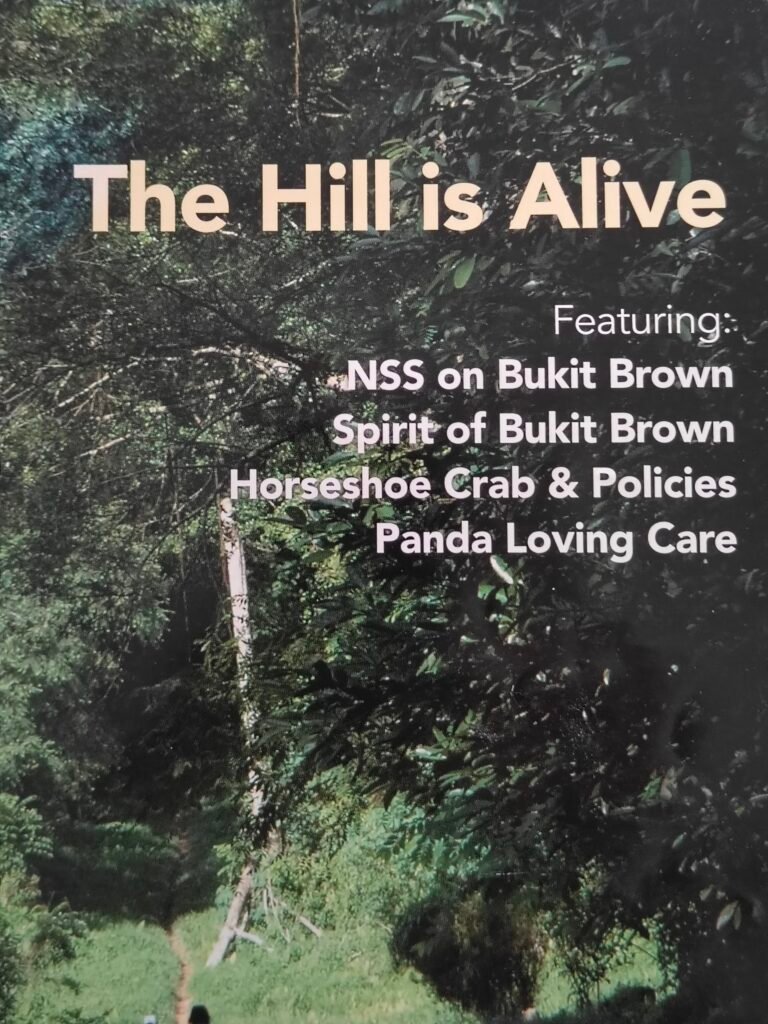


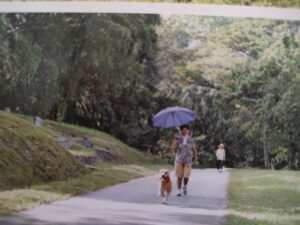

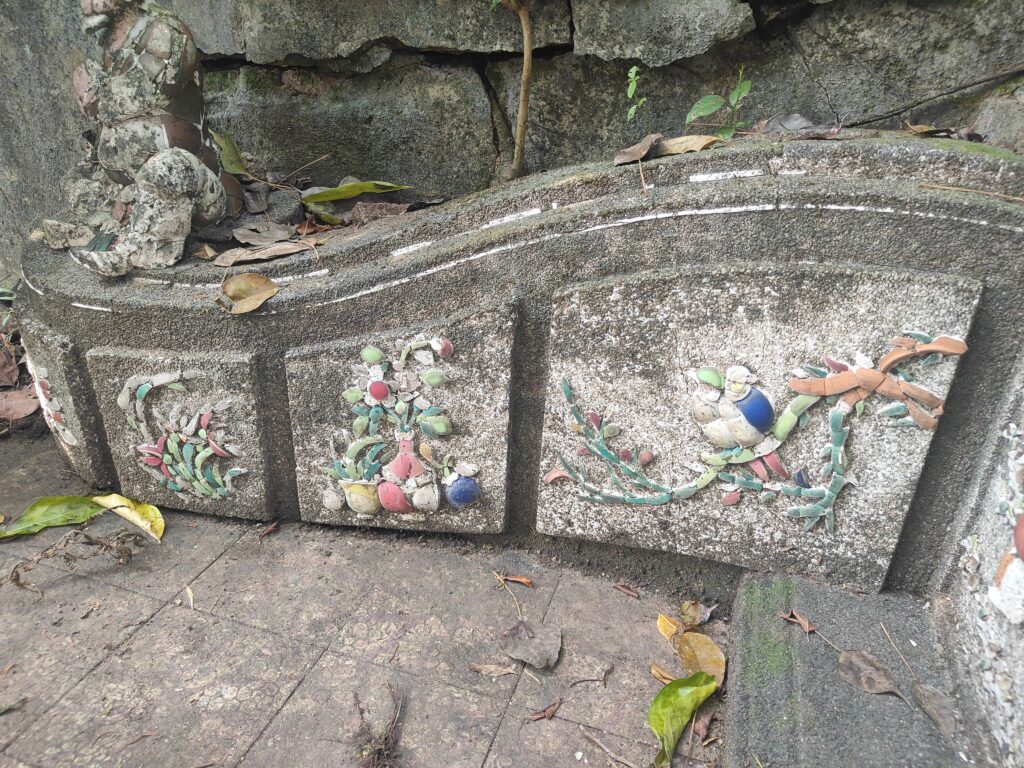
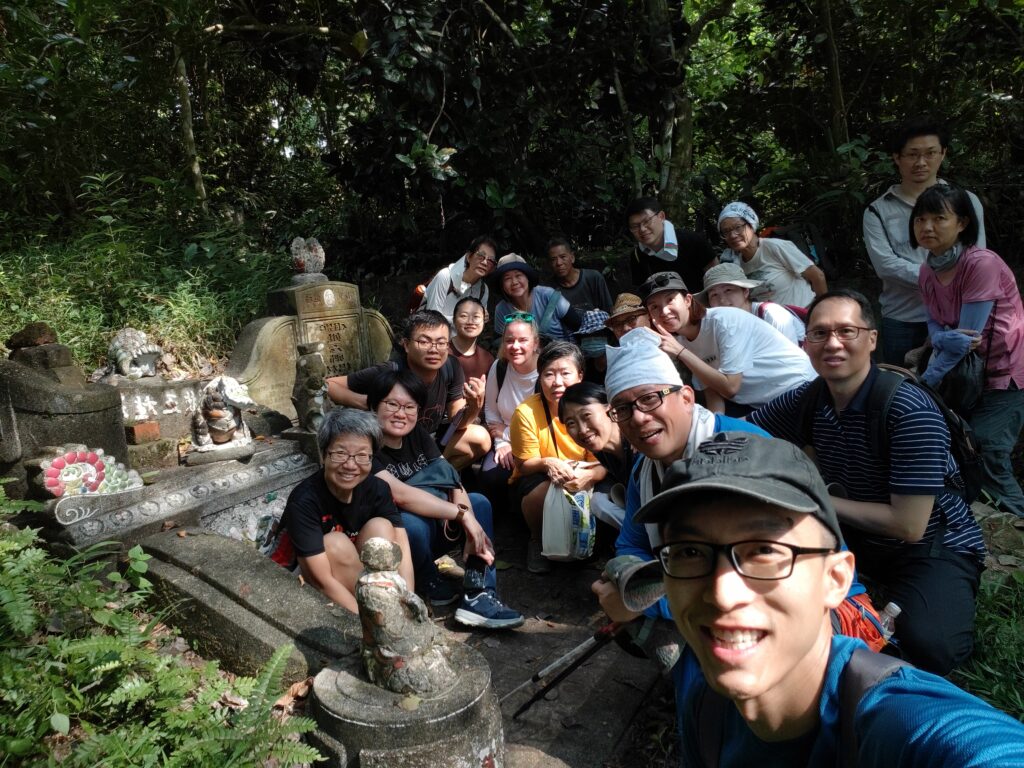
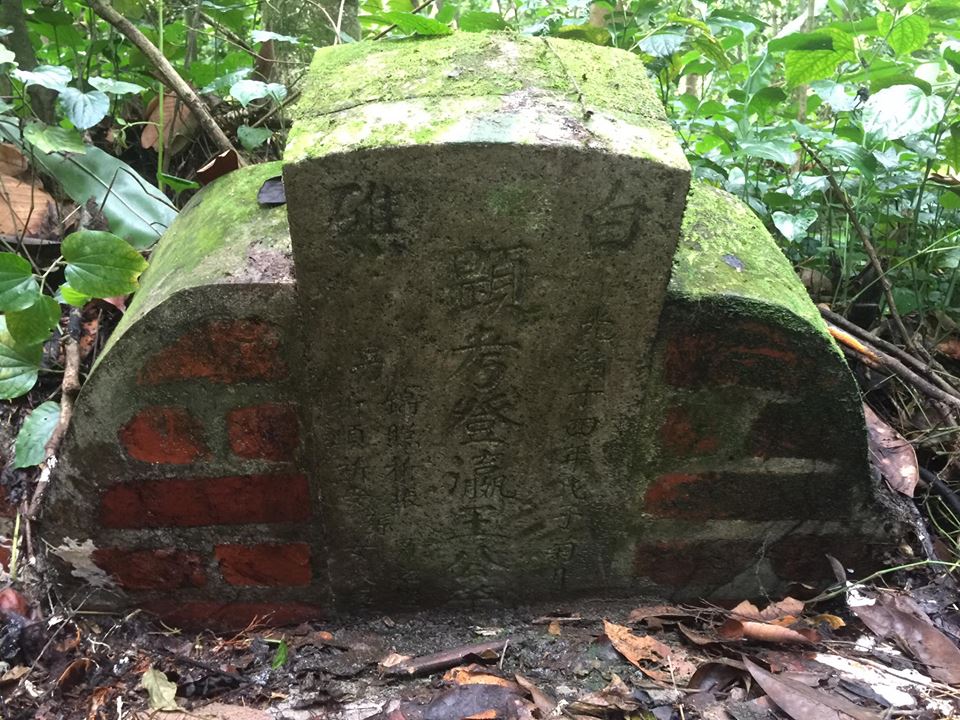
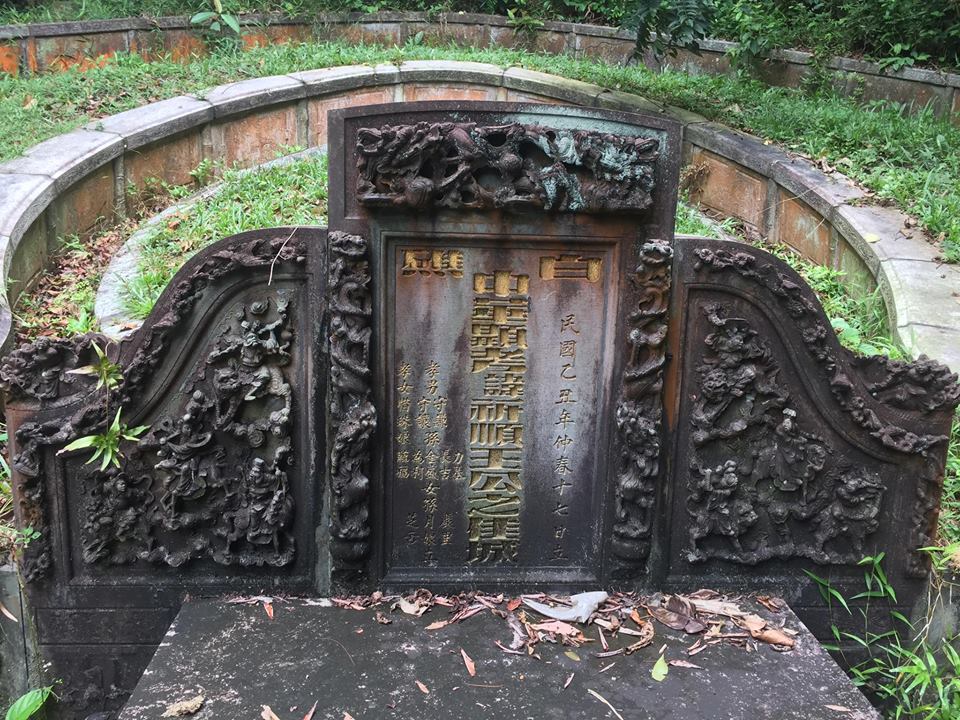

![Bianca guiding the Botanic Garden to Bukit Brown walk [photo: Theresa Teng]](http://bukitbrown.com/main/wp-content/uploads/2016/08/bianca-guiding-photo-by-Theresa-Teng-1024x576.jpg)
![Bianca doing a nasi ulam demo performance at Baba House [photo: Jennifer Teo]](http://bukitbrown.com/main/wp-content/uploads/2016/08/bianca-nasi-ulam-photo-Jennifer-Teo.jpg)

![Bianca guiding at Bukit Brown [photo: Theresa Teng]](http://bukitbrown.com/main/wp-content/uploads/2016/08/bianca-guiding-photo-by-Theresa-Teng2.jpg)
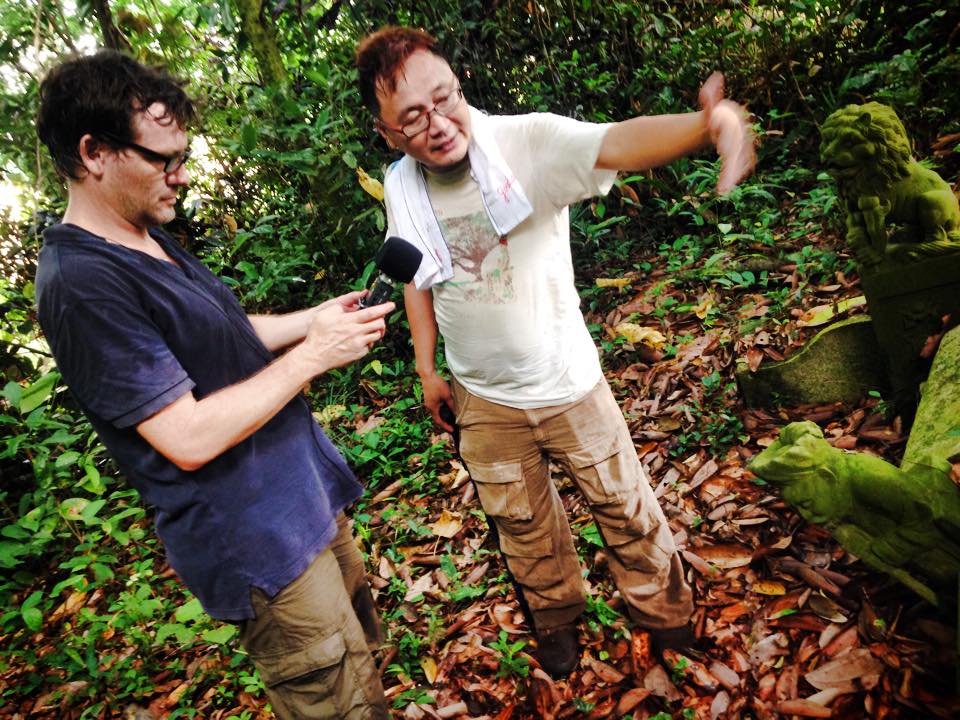


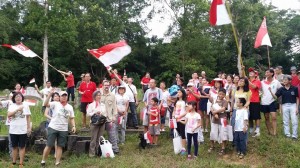
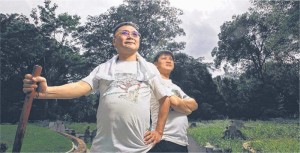

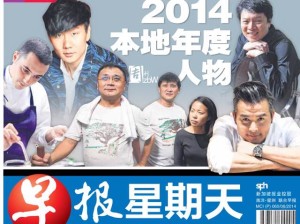









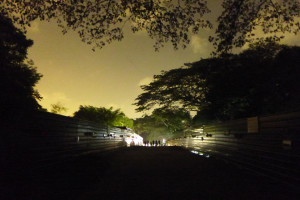
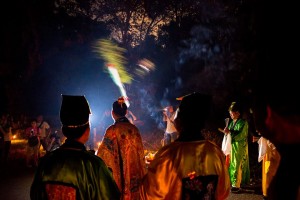

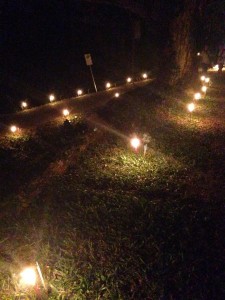
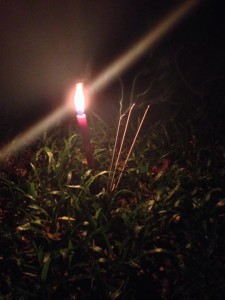
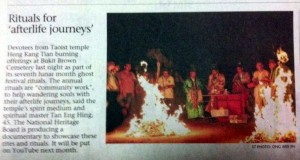
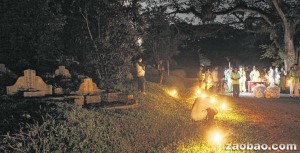
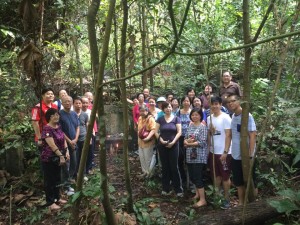

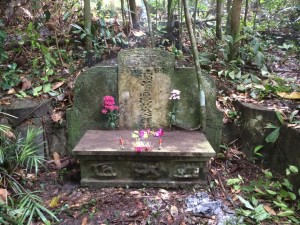

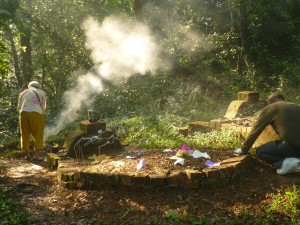
Recent Comments